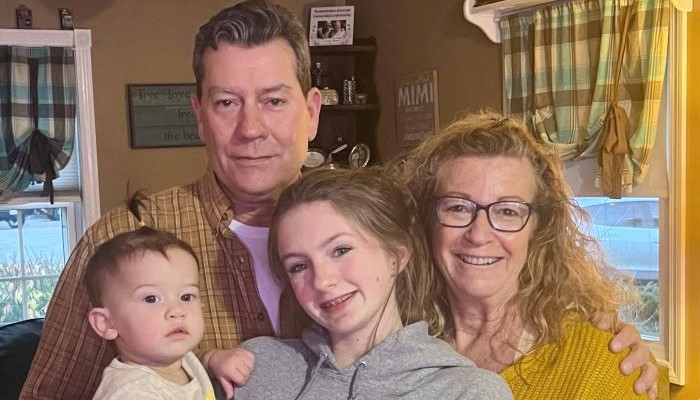Our lung team is devoted to providing the best care and prompt evaluation to all patients. Regardless of where you are in your care journey, we are here for you, both in person and virtually. To request an appointment, please call 1-844-294-5864 or fill out an online appointment request form. To refer a patient, please call 1-800-MD-TO-BWH (1-800-638-6294) or see our list of referral options.
Lung cancer forms in tissues of the lung, usually in the cells lining air passages. It starts from a single cell, but usually includes millions of cells by the time it can be seen by an X-ray. Cancer cells lose their previous function in the body and grow faster than regular cells, causing the body to weaken and prevent organs from working. The two main types of lung cancer are small cell lung cancer, which spreads quickly, and non-small cell lung cancer, which is more common and spreads slowly. More than 225,000 Americans are diagnosed with lung cancer each year. Treatment depends on the type and stage of lung cancer and may include one or more treatments, including surgery, chemotherapy, radiation therapy, or targeted drug therapy.
Cancers of the lung and chest can be challenging to diagnose, and life-saving treatment may require many specialists, including expert lung cancer surgeons. The Lung Center at Brigham and Women's Hospital brings together all the necessary experts in one place to diagnose and treat cancers of the lung, thymus and chest wall.
Our innovative surgeons include pioneers of the most advanced and safest lung cancer treatments. Many surgeries performed at the Lung Center use minimally invasive techniques, in which a smaller incision leads to faster recovery, greater comfort and maximum preservation of healthy lung tissue. Our expertise in minimally invasive surgery and VATS (video-assisted thoracic surgery) as well as robotic surgery—another method for minimally invasive surgery—broadens the range of patients who are candidates for surgery, giving every patient the very best opportunity for successful treatment.
Our thoracic surgeons are the surgical team for Dana-Farber Brigham Cancer Center, an exceptional collaboration between two world-class medical centers.
Our physicians work closely together to provide all the clinical resources you need during your cancer treatment. Your health care team includes distinguished thoracic surgeons, radiation oncologists, pathologists, pulmonologists and medical oncologists. Dana-Farber Brigham Cancer Center's Women's Lung Cancer Program offers advanced care for women with lung cancer along with a wide range of support services.
Many of the new diagnostic tools and advances in the treatment of lung cancer were developed at BWH and Dana-Farber. As part of the evaluation for lung cancer, patients' tumors undergo a molecular evaluation to determine which drugs and procedures are best suited to give the patient the best outcome.
There are two major types of lung cancer:
Smoking tobacco is the most significant risk for developing this type of cancer, typically affecting people older than 45. Factors that contribute to an increased risk for developing lung cancer include:
Lung cancer may not cause any symptoms and may be found on a routine chest X-ray or low-dose chest CT scan. Signs and symptoms of lung cancer may include:
Diagnosis of lung cancer often includes a number of different tests and procedures, many conducted by your thoracic surgeon:
Thoracic surgeon Michael Jaklitsch, MD and thoracic radiologist Francine Jacobson, MD have developed a tool for the American Association for Thoracic Surgery to determine if a patient should be screened for lung cancer.
This unique program offers eligible patients CT scans to screen for lung cancer. Eligible patients must be between the ages of 55 and 79 who smoked one pack of cigarettes a day for 30 years.
Learn more about lung cancer screening.
Learn more about a BWH clinical trial utilizing CAT scans during surgery to better target lung tumors.
The process used to find out if cancer has spread within the lungs or to other parts of the body is called staging. The stage is determined from the results of physical exams, imaging tests and biopsies that have been done. Learn more about the stages of lung cancer.
Depending on its type and stage, lung cancer may be treated with surgery, chemotherapy, radiation therapy, local ablation including laser therapy, or a combination of treatments. Treatment options include:
Surgery
Surgery is usually the best option for treating early-stage lung cancer and may be used to remove a portion of the lung or the entire lung. Our thoracic surgeons have pioneered the use of minimally invasive video-assisted thoracic surgery (VATS), and continue to develop innovative approaches to achieving the best outcomes for lung cancer patients.
Dana-Farber Brigham Cancer Center is home to one of the few dedicated thoracic surgery intensive care units in the country, with sub-specialized nursing staff and state-of-the-art healthcare resources.
Types Of Surgery
Minimally Invasive Surgery
Using minimally invasive surgery techniques over traditional surgeries offers patients many benefits: improved accuracy and visualization, minimized trauma to tissue, less bleeding, decreased pain, less scarring and a shortened recovery.
Read about Image Guided Video Assisted Thoracic Surgery (iVATS)
Non-Surgical Cancer Treatments
The Lung Center at Brigham and Women's Hospital addresses every type and stage of cancer that occurs in the lungs or chest. When you become a patient of The Lung Center you will meet many members of the team who will carefully review your medical history and studies. In addition, you will receive a thorough diagnostic examination where you will receive a recommendation for a therapy tailored just for you, based on your cancer type, stage and wishes.
Our world-class thoracic surgeons, pulmonologists, radiation oncologists, and other specialists ensure that you receive cutting edge treatments. Their technical skill and expertise are matched by their compassion and teamwork. All share a patient-first approach to treating the whole person, from diagnosis through treatment and recovery—and are always available to answer your questions.
As a patient at The Lung Center, you can expect:
The specialists in The Lung Center provide a multidisciplinary approach to patient care, collaborating with colleagues in other medical specialties. Any surgery recommended will be performed by an experienced, board-certified thoracic surgeon who specializes in lung cancer, in collaboration with a treatment team including an oncologist, radiation oncologist, anesthesiologist, radiologist and pathologist, as well as nurses and physician assistants, all of whom specialize in taking care of patients with lung cancer or thoracic conditions. Your surgeon works in close collaboration with the experts in the Thoracic Oncology Program to tailor an individual treatment plan for you. Our specialized care team has some of the best results in the country. After treatment, routine life-long surveillance will be necessary.

Sunny's journey with lung cancer has been filled with challenges, starting from a seemingly innocent tickle in her throat. After months of misdiagnosis and uncertainty at her local hospital led to the discovery of a baseball-sized tumor in her lung, Sunny sought help at Dana-Farber Brigham Cancer Center.

Sharon was enjoying a cruise from Boston to Bermuda with her husband when she started coughing up blood. The diagnosis confirmed that she had squamous cell carcinoma in the right upper lobe of her lung. Read more about Sharon's road to recovery.

After a pioneering minimally invasive lung surgery for Stage III adenocarcinoma, Joan has been cancer-free for six years. Despite losing her right lung, she continues to travel extensively, exploring places like Patagonia and Zion National Park, among her many adventures. Read her inspiring story here.
For over a century, a leader in patient care, medical education and research, with expertise in virtually every specialty of medicine and surgery.
About BWH